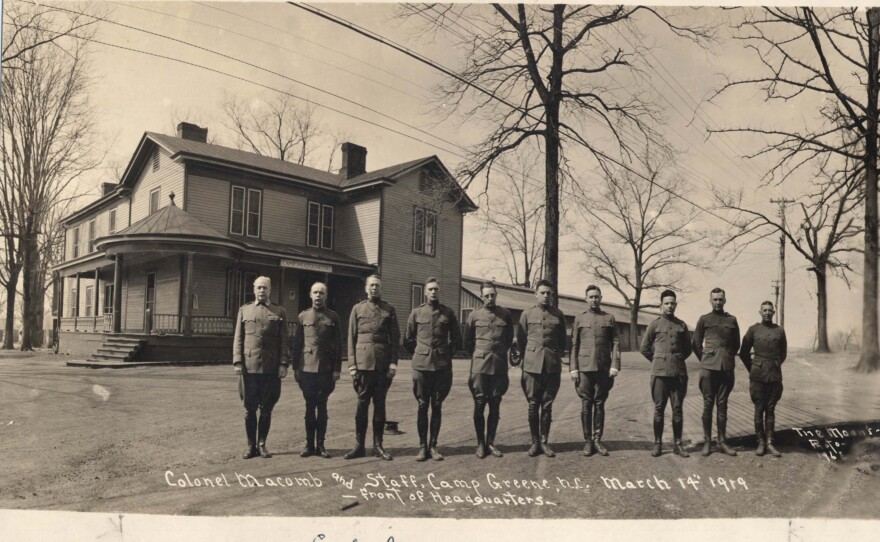This weekend there will be a commemoration marking the 100th anniversary of a lesser known piece of Charlotte's history. In the summer of 1917, the U.S. Army established a training camp on what is today the city’s westside. It was called Camp Greene and at its peak there were up to 60,000 troops there training for the battlefields of World War One. That was almost double the amount of people in Charlotte at the time.
Today, the neighborhood where the camp used to be is, also, called Camp Greene. It's just south of Philip O. Berry Academy and includes the old Dairy Queen on Wilkinson Boulevard. Most of the modest homes were built in the '40s and '50s. Eddie Johnson loves it here.
"It's just beautiful," Johnson says. "Mature trees. The animals and nature sounds. You'd never guess you're two miles from uptown Charlotte."
Johnson moved here in 2005. Before he did though, an old neighbor gave him grief about moving to the area.
"It's horrible that west Charlotte has this bad reputation, and it's largely undeserved," Johnson says. "Then we all sort of snicker and say 'eh, it's our little secret.'"

It wasn't until the early 2000s the neighborhood began referring to itself as Camp Greene. That got longtime resident Cynthia Harrison curious.
"And I said, 'something's going on with the name,'" Harrison says. "So when I started doing the research, then I found out about the history of our area."
Johnson and Harrison are with the Camp Greene Neighborhood Association, which organized this weekend's commemoration. They're proud of their neighborhood's history and want to instill that pride in other residents.
At nearby Camp Greene Park, there are several basketball courts and a greenway snakes through the woods. One hundred years ago in this spot you would have seen thousands of young men learning how to use a bayonet and training in mock trenches. The kind of trenches they would soon find themselves in in Europe. Jack Dillard made the 2011 documentary City of Canvas, a reference to the canvas tents erected to house the troops.
"By the time the camp ended there had been three divisions that came through here," Dillard says. "It was one of the largest camps, at least in the South."
When the U.S. entered World War 1 in April 1917, it needed to train about 500,000 troops in a short time. Men were drafted and 32 camps were built to train them. The South was an ideal location because of the mild weather. And Charlotte stood out.
"Charlotte had a great combination of available land, access to water, and a freight line right by this particular area," Dillard says.
It was a big get for a small, quiet mill town. The army settled on about 2,600 acres between what is today Wilkinson Boulevard and Tuckaseegee Road and named it after Revolutionary War hero Nathaniel Greene. The camp sprung up quickly. In September, two months after construction started, the first soldiers were arriving. They came from all over the U.S, including more than 14,000 black troops, many from the northeast. It was a city unto itself. There was a hospital, a post office, a bakery, a YMCA, even an airfield.
"The airfield was to my understanding where Freedom Mall used to be, so not far from where we are," Dillard says.
And almost from the beginning, there were problems. A big one was the weather. Several days of rain turned the camp into a giant mud pit. Training was hampered. It was hard to get supplies in and out. Making matters worse, that winter was one of the worst in Charlotte’s history. When the snow and ice melted, the mud got worse.
It was realistic preparation for the battlefield, says Jessica Bandel, a state historian and author of "North Carolina and the Great War 1914-1918."
"Just being in the trenches, constantly wet, constantly caked in mud, not having the ability just to get clean," Bandel says. "Being in such close proximity, diseases spread very easily."
In the fall of 1918, the influenza pandemic is estimated to have claimed 300 to 400 of the camp's soldiers. That November the war ended and just over a year after Camp Greene opened, it began to come down. Although it wasn’t here long, it left a mark on Charlotte.
"It increased business," Dillard says. "8,200 building permits in the three or four years after Camp Greene were put out there. In the banks, the deposits increased considerably. It really put Charlotte on the map."

There's little left today of Camp Greene. The only remaining structure is The Dowd house, a 19th century home that served as the camp's headquarters. There's a monument to the camp just down the road. Remount Road ran by the camp's Remount Station, where soldiers picked up their horses.
Camp Greene residents like Cynthia Harrison hope this weekend's celebration will put their neighborhood and its hidden history on the map.
"This is going to make our neighborhood even more known to the city of Charlotte, because we are a part of that," Harrison says.
The 100th anniversary commemoration of Camp Greene is Saturday at the corner of Wilkinson Boulevard and Monument Street.









